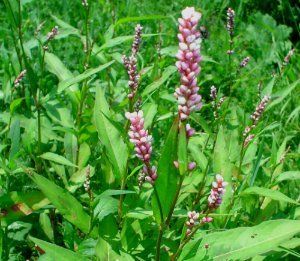Description: Lady's Thumb, scientifically known as Persicaria maculosa, is an annual flowering plant belonging to the knotweed family (Polygonaceae). Characterized by its lance-shaped leaves marked with a distinctive dark spot resembling a "lady's thumbprint," this plant is found in a variety of habitats. Lady's Thumb produces small, pink to white flower spikes and is known for its adaptability to different soil conditions.
Habitat and Distribution: Lady's Thumb is commonly found in gardens, agricultural fields, and disturbed areas. It thrives in moist, fertile soil but can tolerate a range of conditions, making it a resilient and widespread weed. Native to Eurasia, it has become naturalized in North America and other regions.
Physical Features: Leaves: The leaves are lance-shaped with a dark blotch in the center, resembling a thumbprint. The foliage has a distinct green to reddish tint.
Flowers: Small, inconspicuous flowers form dense spikes at the ends of stems, ranging in color from pink to white.
Invasive Characteristics: Lady's Thumb has the potential to become invasive due to its prolific seed production and adaptability to various environments. It competes with crops and desirable plants for resources, making it a challenge for gardeners and farmers to manage.
Control Methods:
- Manual Removal: Hand pulling or using garden tools to uproot Lady's Thumb is effective for small infestations. Be thorough to remove the entire root system to prevent regrowth.
- Mulching: Applying a layer of organic mulch can suppress Lady's Thumb growth by blocking sunlight and preventing seed germination. Mulching also helps retain soil moisture and improves overall soil health.
- Herbicides: Selective herbicides designed for broadleaf weed control can be used to target Lady's Thumb. Carefully follow the application instructions to avoid harm to desirable plants.
- Crop Rotation: Implementing crop rotation practices can disrupt the lifecycle of Lady's Thumb and reduce its prevalence in agricultural settings.
Preventing Spread:
- Early Detection: Regularly inspecting and promptly addressing any new growth of Lady's Thumb can prevent it from establishing a widespread presence.
- Soil Health: Improving soil health through proper fertilization and pH management can discourage the growth of Lady's Thumb and promote the success of desirable plants.
Competition with Other Plants:
Planting competitive cover crops or companion plants can help limit the spread of Lady's Thumb. Examples include:
- Buckwheat (Fagopyrum esculentum): A quick-growing cover crop that competes for resources and suppresses weed growth.
- Clover (Trifolium spp.): Acts as a ground cover, limiting space and resources available for Lady's Thumb.
In conclusion, Lady's Thumb control involves a combination of manual, chemical, and preventive measures. By understanding its invasive characteristics and implementing effective strategies, it is possible to manage and mitigate the impact of this resilient weed in various settings.



